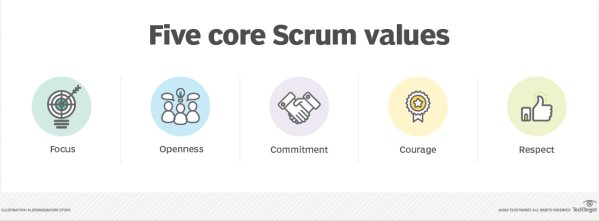What is a Scrum commitment?

Every arrow needs a target.
Without a target, an archer doesn’t know where to aim. Nor would they know if they ever hit their mark.
In Scrum, artifacts are the arrows. Scrum commitments are the targets.
The Scrum Guide demands that work revolves around the following three artifacts:
- A product backlog that represents every feature to be developed;
- A list of backlog items selected for the Sprint; and
- Increments of progress that stakeholders can regularly review
Scrum commitment definition
Since the Scrum Guide’s 2020 update, each artifact now maps to a Scrum commitment.
A Scrum commitment is the evaluation criteria against which a Scrum artifact is measured. Scrum commitments improve transparency and enhance an Agile Scrum developer’s focus as the project progresses.
“Each artifact contains a commitment to ensure it provides information that enhances transparency and focus against which progress can be measured.”
– The 2020 Scrum Guide, page 10
What are the 3 Scrum commitments?
The 2020 Scrum Guide defines three commitments that match up with the three Scrum artifacts listed above:
- The product backlog’s Scrum commitment is to the product goal.
- The sprint backlog ‘s Scrum commitment is to the sprint goal.
- The increment’s Scrum commitment is to to the definition of done.

The three Scrum commitments are different from the core Scrum value of commitment.
Why do we need Scrum commitments?
Agile DevOps practitioners don’t like plans. In fact, “responding to change over following a plan” is one of the four declared values stated in the Agile Manifesto.
Plans aren’t inherently bad. In Scrum, every sprint begins with a sprint planning session. Planning is a requirement of the sprint framework. Not planning is definitely an Agile anti-pattern.
The problem is that when conscientious people get a plan, they do their best to follow it. Sometimes that is counter-productive, especially when conditions change, which they inevitably do.
Scrum commitments, goals and plans
Compared to a plan, a Scrum commitment is a higher-order calling to which team members aspire. “Shifting from plan-driven work to goal-driven work leads to a lot more flexibility,” said Dr. Charles (Chuck) Suscheck, a professional Scrum trainer in Hamilton, OH.
The main purpose of the three commitments is to provide a clear, shared, and agreed upon goal that guides all work. The commitments also encourage participants to constantly evaluate how effectively their planned work will help the team follow through on a given commitment.
If the work, plan and commitment are misaligned, developers should sound the alarm and change the plan, because the commitment represents a higher calling than the plan.
“If the team cannot complete selected product backlog items during a sprint, the plan may need to change in order to meet the sprint goal,” Suscheck said. “The commitment is to the sprint goal, not the details.”
Empiricism and Scrum commitments
The Scrum framework’s three pillars of empiricism are:
- transparency;
- inspection; and
- adaptation.
With a clear product goal, well-defined sprint goal and a concise definition of done, the software development process is more transparent and becomes more Agile.
This allows stakeholders to objectively inspect the project’s progress, and immediately change and adapt when individual efforts don’t align with the team’s greater commitments.
Before an archer pulls back her bow, she aims at a target.
For Scrum practitioners, the Scrum commitment is the target to which their artifacts aim.
Darcy DeClute is a Certified Cloud Practitioner and author of the Scrum Master Certification Guide. Popular both on Udemy and social media, Darcy’s @Scrumtuous account has well over 250K followers on Twitter/X.
| Jira, Scrum & AI Certification |
|---|
| Want to get certified on the most popular software development technologies of the day? These resources will help you get Jira certified, Scrum certified and even AI Practitioner certified so your resume really stands out..
You can even get certified in the latest AI, ML and DevOps technologies. Advance your career today. |



